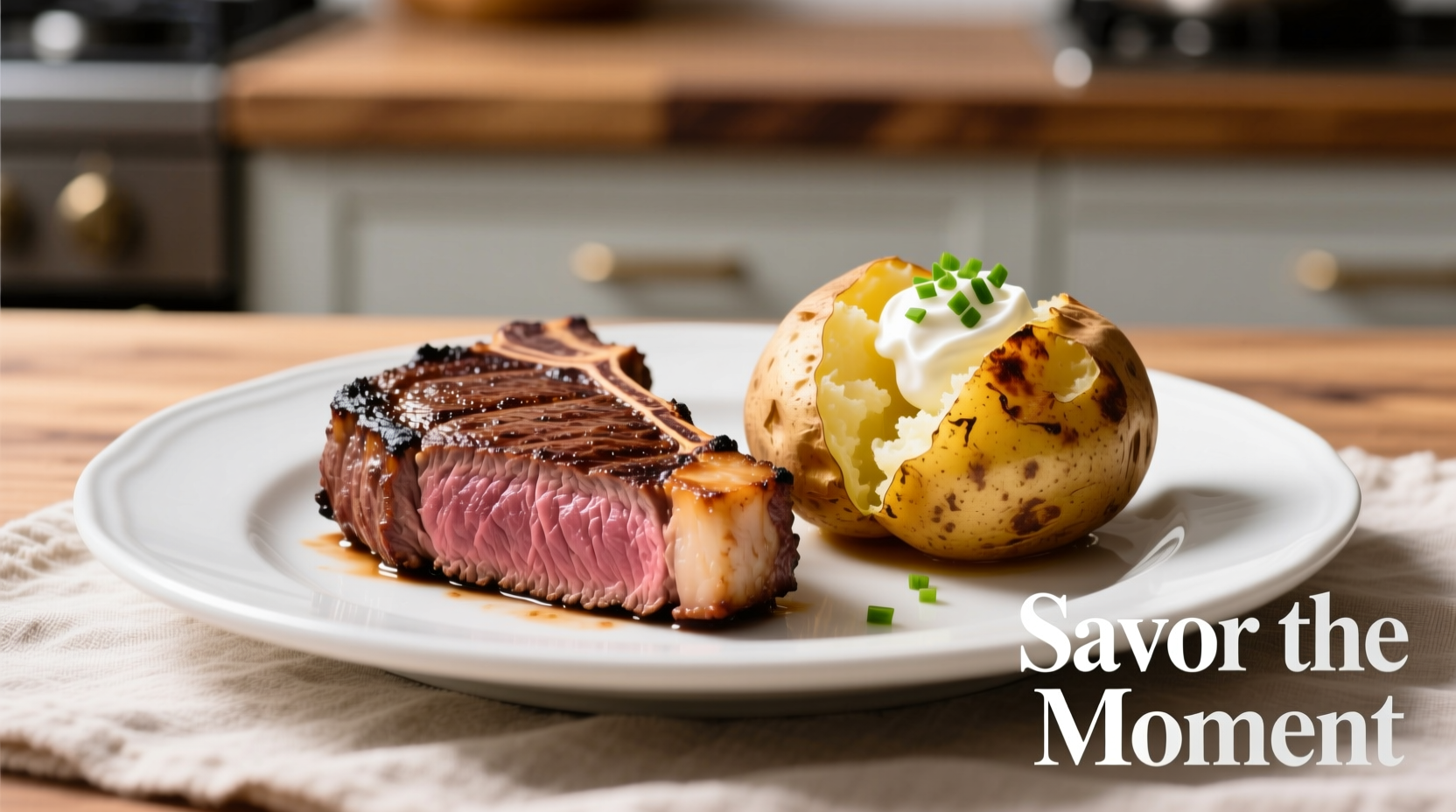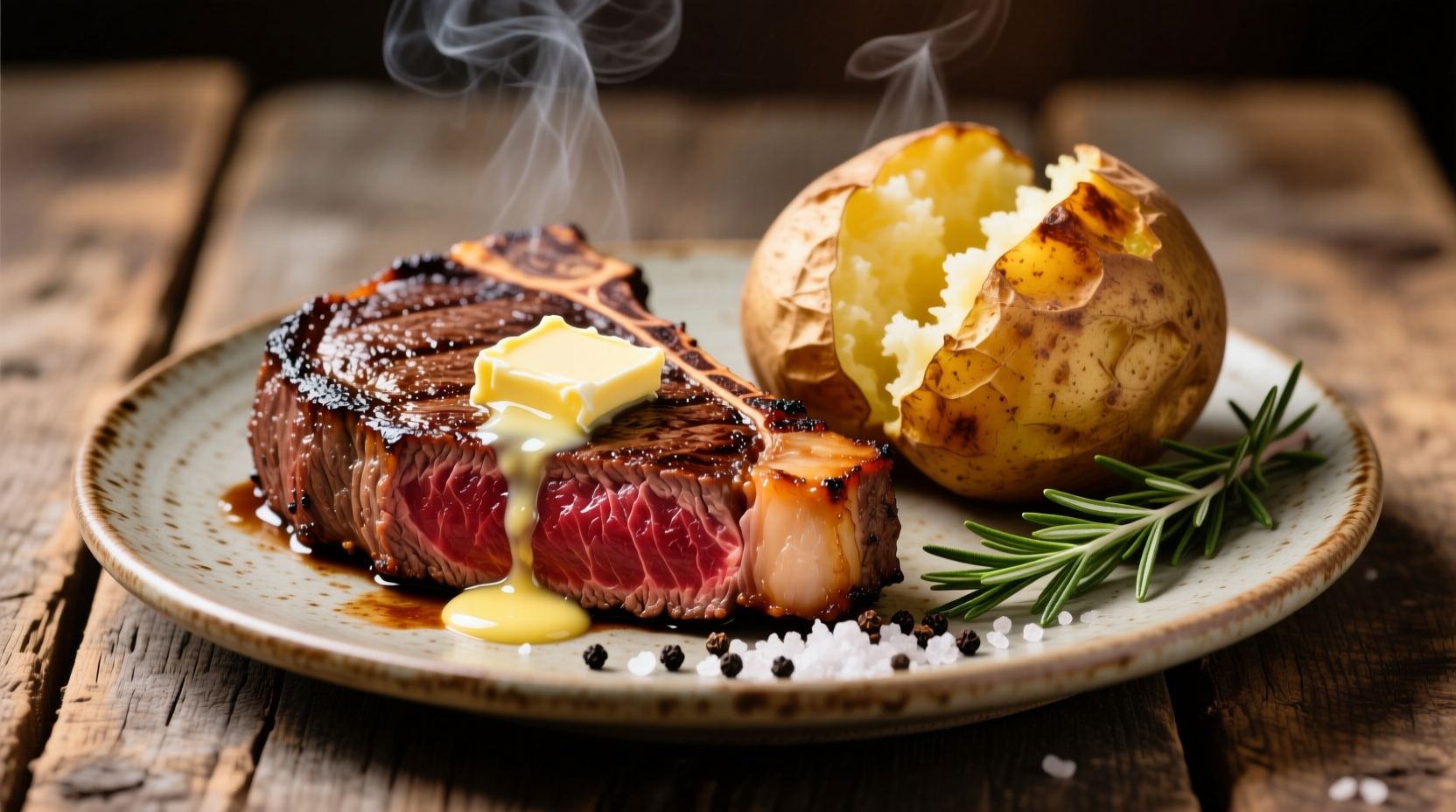Perfectly cooked steak with a fluffy baked potato delivers a satisfying meal that's achievable at home with proper technique. This guide reveals chef-tested methods for achieving restaurant-quality results, including USDA-recommended internal temperatures (145°F for medium-rare steak), optimal baking times (45-60 minutes at 400°F), and professional seasoning techniques that transform simple ingredients into an exceptional dining experience.
There's something deeply satisfying about the classic pairing of steak and baked potato—a combination that has graced dinner tables for generations. Whether you're cooking for a special occasion or a weeknight dinner, mastering this timeless duo requires understanding both components' nuances. This comprehensive guide provides everything you need to create a perfectly balanced meal where each element shines without overpowering the other.
Essential Ingredients Selection Guide
Choosing quality ingredients forms the foundation of an exceptional steak and baked potato dinner. Not all cuts and potatoes perform equally in this classic pairing.
| Steak Cut | Best For | Recommended Thickness |
|---|---|---|
| Ribeye | Rich flavor, marbling | 1.5 inches |
| New York Strip | Balanced flavor and texture | 1.25 inches |
| Filet Mignon | Tender, mild flavor | 2 inches |
For potatoes, select Russet varieties for their high starch content which creates that desirable fluffy interior. Look for firm, blemish-free specimens about the size of your palm—this ensures even cooking when paired with your steak. Avoid refrigerating potatoes as cold temperatures convert starches to sugars, affecting both texture and flavor during baking.

Step-by-Step Cooking Process
Timing coordination between steak and potato determines whether you serve a harmonious meal or a rushed compromise. Follow this professional sequence for optimal results:
Preparing the Potato First
Begin by preheating your oven to 400°F (204°C). While it heats, thoroughly wash and dry your Russet potatoes. Pierce each potato 4-6 times with a fork to allow steam to escape during baking—this prevents bursting. For crispier skin, rub with 1 teaspoon of olive oil and sprinkle with coarse salt before baking.
Place potatoes directly on the middle oven rack with a baking sheet on the rack below to catch any drips. Bake for 45-60 minutes depending on size, until a fork inserts easily into the center. The USDA Food Safety and Inspection Service recommends baking potatoes until they reach an internal temperature of 210°F (99°C) for optimal texture.
Perfecting the Steak
While potatoes bake, prepare your steak. Remove steak from refrigeration 30-45 minutes before cooking to bring it to room temperature—this ensures even cooking. Pat the surface completely dry with paper towels; moisture prevents proper searing.
Season generously with coarse kosher salt and freshly ground black pepper. For enhanced flavor development, add garlic powder and a pinch of smoked paprika. Professional chefs recommend using approximately 1 teaspoon of salt per pound of meat, applied at least 40 minutes before cooking to allow proper penetration.
Mastering the Sear
The quality of your sear determines both flavor and appearance. Use a heavy cast-iron skillet or stainless steel pan preheated over medium-high heat for 5 minutes. Add high smoke-point oil (avocado or grapeseed) just before adding the steak.
Place steak in the hot pan, pressing gently to ensure full contact. Cook undisturbed for 3-4 minutes until a deep brown crust forms. Flip and repeat on the second side. For thicker cuts (over 1.5 inches), finish in a 400°F oven for 5-8 minutes to reach desired doneness without overcooking the exterior.
According to the USDA's Food Safety and Inspection Service, steak should reach these minimum internal temperatures for safety:
- Rare: 125°F (52°C) - pulls to 130°F
- Medium-rare: 135°F (57°C) - pulls to 140°F
- Medium: 145°F (63°C) - pulls to 150°F
- Medium-well: 150°F (66°C) - pulls to 155°F
- Well-done: 160°F (71°C)
Always use an instant-read thermometer for accuracy—relying solely on touch or timing leads to inconsistent results.
Resting and Final Assembly
Resting your steak for 5-10 minutes (longer for thicker cuts) allows juices to redistribute. During this critical phase, prepare your potato toppings. Slice the baked potato lengthwise, fluff the interior with a fork, and add your preferred seasonings.
For balanced flavors, consider these classic topping combinations:
- Traditional: Butter, sour cream, chives, salt, and pepper
- Loaded: Crispy bacon, shredded cheese, green onions, and jalapeños
- Healthy: Greek yogurt, steamed broccoli, and everything bagel seasoning
Avoiding Common Pitfalls
Even experienced cooks make these frequent mistakes when preparing steak and baked potato:
- Skipping the rest period: Cutting into steak immediately after cooking releases precious juices onto the cutting board instead of staying in the meat
- Overstuffing potatoes: Adding too many toppings overwhelms the delicate potato flavor
- Incorrect oven temperature: Baking potatoes below 375°F creates dense, gummy interiors
- Using cold steak: Starting with refrigerator-cold meat creates uneven cooking with a gray band around the exterior
Nutritional Profile and Serving Suggestions
A standard serving (6oz steak with 1 medium baked potato with moderate toppings) contains approximately:
- Calories: 550-700
- Protein: 40-45g
- Carbohydrates: 45-55g
- Fat: 25-35g
For a more balanced meal, pair your steak and potato with roasted vegetables or a crisp green salad. The vibrant colors and textures complement the hearty main course while adding essential nutrients. Consider these wine pairings that enhance rather than compete with your meal:
- Ribeye: Full-bodied Cabernet Sauvignon
- New York Strip: Medium-bodied Merlot
- Filet Mignon: Elegant Pinot Noir
Historical Context of This Classic Pairing
The steak and baked potato combination emerged as a popular American dinner in the mid-20th century, though both components have much longer histories. Potatoes were introduced to Europe from South America in the 16th century, while steak became widely accessible in America with the expansion of cattle ranching after the Civil War. The pairing gained popularity in American steakhouses during the 1950s when baked potatoes became a standard side dish, replacing boiled potatoes which were more common in earlier decades.
FAQs About Steak and Baked Potato
How do I prevent my baked potato from becoming dry?
Prevent dryness by baking potatoes at 400°F rather than higher temperatures, which can cause moisture loss. Don't overbake—remove when a fork inserts easily but the center still has slight resistance. For extra moisture, add a small pat of butter to the fluffed interior immediately after baking.
Can I bake potatoes ahead of time for a dinner party?
Yes, bake potatoes completely, then wrap tightly in foil and hold in a 200°F oven for up to 2 hours. For longer storage, cool completely, refrigerate, and reheat in a 350°F oven for 20-25 minutes. Avoid microwaving reheated potatoes as this creates uneven texture.
Why does my steak always stick to the pan?
Steak sticks when the pan isn't hot enough or when you try to move it too soon. Ensure your pan is properly preheated (a drop of water should sizzle and evaporate immediately), and don't touch the steak for the first 3-4 minutes of cooking. Properly seared steak will naturally release from the pan surface when ready to flip.
What's the best way to reheat leftover steak without overcooking?
Reheat steak gently using the reverse-sear method: place in a 250°F oven until the internal temperature reaches 110°F, then quickly sear for 60 seconds per side in a hot pan. This preserves moisture while restoring the crust. Never microwave steak, as it creates uneven texture and rubbery results.











 浙公网安备
33010002000092号
浙公网安备
33010002000092号 浙B2-20120091-4
浙B2-20120091-4